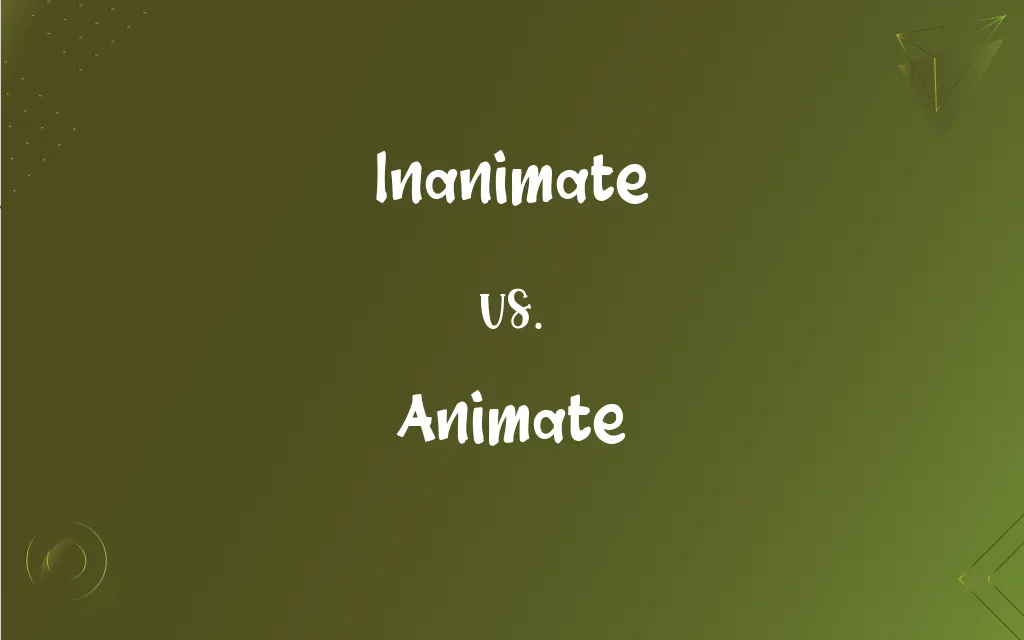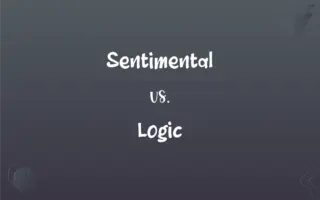Inanimate vs. Animate: What's the Difference?
Edited by Aimie Carlson || By Janet White || Updated on November 13, 2023
Inanimate refers to things that lack life or consciousness, like rocks or machines; animate pertains to things that possess life or exhibit qualities of life, like animals or humans.

Key Differences
Inanimate objects lack biological life, consciousness, and self-initiated movement. Animate entities possess life, can exhibit consciousness, and often have the capability for self-movement.
In nature, inanimate things include rocks, water, and air, devoid of life and growth. Animate things in nature encompass animals, humans, and plants, all showing growth, development, and life processes.
The term inanimate is often used to describe objects without life, especially when emphasizing their non-living status. Animate is used to describe living beings, particularly when highlighting their life-like qualities or movements.
Inanimate objects in art and literature are often used symbolically or as static elements. Animate beings in art and literature are usually central, portrayed with characteristics that reflect life or emotion.
In philosophy and science, inanimate refers to entities lacking organic life or consciousness. Animate is used in these contexts to discuss entities with biological life and, in some cases, consciousness and sentience.
ADVERTISEMENT
Comparison Chart
Definition
Lacking life, consciousness, self-movement
Possessing life, potential for consciousness, self-movement
Examples
Rocks, machines, furniture
Animals, humans, plants
Usage in Language
Describes non-living objects
Describes living beings
Representation in Arts
Symbolic, static
Central, life-like, emotional
Context in Philosophy/Science
Entities without organic life or consciousness
Entities with biological life, possibly consciousness
ADVERTISEMENT
Inanimate and Animate Definitions
Inanimate
Not alive, especially not in the manner of animals and humans.
Rocks and minerals are inanimate objects.
Animate
Alive, especially in contrast to inanimate objects.
Birds, as animate creatures, display fascinating behaviors.
Inanimate
Devoid of consciousness and self-movement.
The inanimate robot could not initiate action on its own.
Animate
Endowed with or showing signs of life.
The animate forest was teeming with wildlife.
Inanimate
Lacking the qualities of life or living organisms.
The inanimate statue stood silently in the museum.
Animate
Possessing or exhibiting qualities of life.
The animate puppy wagged its tail excitedly.
Inanimate
Lifeless or inert, especially in contrast to animate beings.
The room was filled with inanimate furniture.
Animate
Capable of growth, development, and reproduction.
Plants are animate beings that grow and reproduce.
Inanimate
Not capable of growth, development, or reproduction.
The inanimate landscape painting captured the stillness of nature.
Animate
Exhibiting movements indicative of life or consciousness.
Her animate expression conveyed her emotions vividly.
Inanimate
Not having the qualities associated with active, living organisms.
Animate
To give life to; fill with life
The belief that the soul animates the body.
Inanimate
Not animated or energetic; dull.
Animate
To impart interest or zest to; enliven
"voices animated by food, drink, and company" (Anita Desai).
Animate
To fill with spirit, courage, or resolution
"a wave of exploratory voyages animated by a spirit of scientific inquiry" (Lincoln P. Paine).
FAQs
Is water inanimate?
Yes, it lacks qualities of life.
Are plants considered animate?
Yes, as they possess life and growth.
Are all objects either animate or inanimate?
Generally, yes, based on their life status.
Do animate objects always move?
Not necessarily; some may be stationary but still alive.
Can something be both animate and inanimate?
No, they are mutually exclusive categories.
Are viruses considered animate?
They're a gray area, often considered inanimate.
Are computers animate or inanimate?
They are inanimate, despite their complex functions.
Is animation related to the term animate?
Yes, it refers to giving the illusion of life or movement.
Can inanimate objects become animate?
In a literal sense, no; in fiction or metaphorically, yes.
Do inanimate objects have energy?
They may have physical energy, but not life energy.
Can robots be considered animate?
In a strict biological sense, no.
Is fire animate or inanimate?
It's considered inanimate as it lacks life characteristics.
Are all living things animate?
Yes, by definition of being alive.
Can inanimate objects affect animate beings?
Yes, physically or emotionally.
Can art depict inanimate objects as animate?
Yes, this is a common artistic technique.
Are emotions animate or inanimate?
They are qualities of animate beings.
Is the sun animate or inanimate?
It is inanimate, despite its energy.
Can inanimate objects have symbolic life in literature?
Yes, they often carry symbolic or metaphorical life.
Is the earth animate or inanimate?
It is inanimate, though it supports animate life.
Do animate beings always have consciousness?
Not always, as some life forms lack consciousness.
About Author
Written by
Janet WhiteJanet White has been an esteemed writer and blogger for Difference Wiki. Holding a Master's degree in Science and Medical Journalism from the prestigious Boston University, she has consistently demonstrated her expertise and passion for her field. When she's not immersed in her work, Janet relishes her time exercising, delving into a good book, and cherishing moments with friends and family.
Edited by
Aimie CarlsonAimie Carlson, holding a master's degree in English literature, is a fervent English language enthusiast. She lends her writing talents to Difference Wiki, a prominent website that specializes in comparisons, offering readers insightful analyses that both captivate and inform.































































